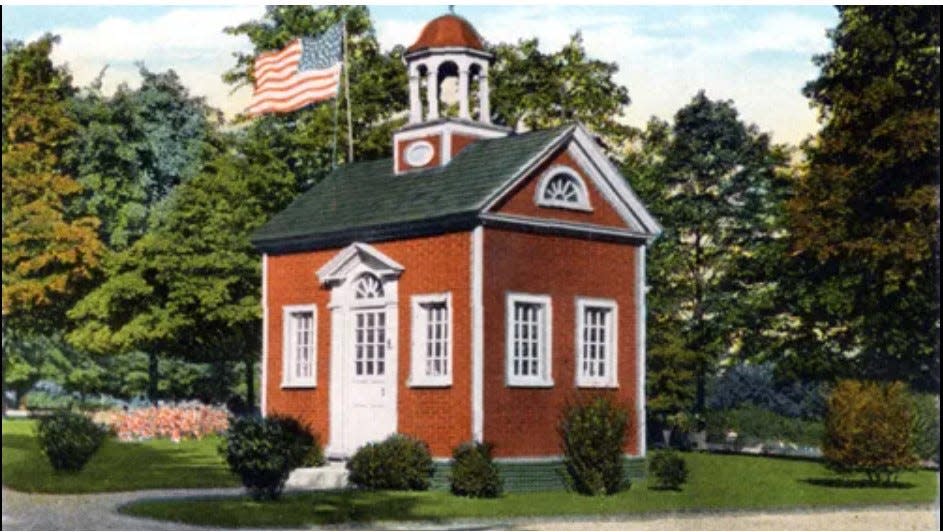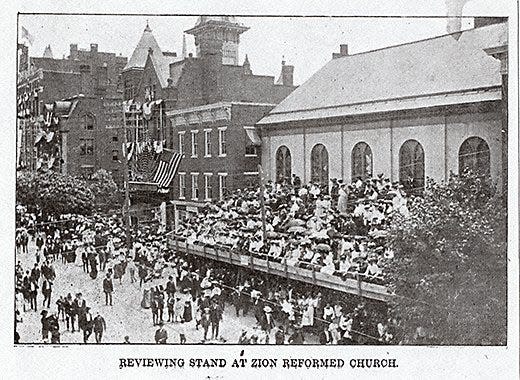York County in American Revolution: Three big anniversaries. Three chances to learn
- Oops!Something went wrong.Please try again later.
(Editor’s note: This is another in a series of occasional columns on York County’s role in the American Revolution).
Statesman Richard Henry Lee scored a three-cornered hat trick on June 7, 1776, in Philadelphia.
Lee, one of the influential Lees of Virginia, introduced a resolution in Continental Congress proposing the independence of the 13 American Colonies.
The hat trick comes from his three-part proposal for independence against British rule in the American Revolution: a declaration of independence, a plan for confederation and a call for foreign alliances or treaties.
He scored on all three proposals.
Within a month, Congress adopted the Declaration of Independence. Within about 16 months, Congress had crafted a plan for confederation, a constitution – the Articles of Confederation. And within two years, Congress ratified two treaties with France.
The Declaration, as we know, was put forth in Philadelphia.
The latter two of Lee’s proposals were completed when Congress was meeting in York County.
Think about that for a second: York had a strong tie to two of three crucial early foundational acts in America. And two of the 56 signers of the Declaration — James Smith and Philip Livingston — are buried in York County. Twenty-six of those signers served in Continental Congress – the national legislature – in York.

Birthdays for 3 foundational documents
York County joins the rest of America in planning for three 250th anniversaries of the Declaration, Articles and Treaties with France. These are opportunities to understand these three foundational American moments more fully.
Local, state and national celebrations are planned for the 250th anniversary of the Declaration in 2026. In 2027, national attention will likely subside, but local organizations are expected to do things to enhance knowledge of the last two: the 250th of the Articles and two Treaties with France – the Treaty of Amity and Commerce and the Treaty of Alliance.
Locally in the past 25 years, the American Revolution and Continental Congress’ nine-month visit to the frontier town of York have lost ground to Civil War studies. This catch-up in our understanding of our considerable Civil War history is past due.
But we have these anniversary years as a moment to rekindle understanding in the American Revolution and what Continental Congress accomplished in York in their stay that covered all or parts of four seasons in 1777-78.
For example, national scholars widely consider the Articles of Confederation as America’s first constitution. And when discussing this framework of 13 articles, many treat it as worthy of respect and study, while recognizing the document’s flaws.
“I want to give a little love to the Articles of Confederation in 1777,” Baylor University’s Ronald Angelo Johnson said on a recent “Ben Franklin’s World” podcast.
He noted that the Articles provided a set of principles that America could use to live together and build upon.
“I think that’s a wonderful legacy,” he said.
It was a wartime document, he said, that provided a foundation for America in the war and helped secure badly needed treaties with France and other foreign powers. They couldn’t support the full weight of a nation on the other side of the war, he noted, but the Articles’ replacement, the U.S. Constitution, took care of that.

The Articles’ intriguing elements
The Articles of Confederation feature ideas that demand our attention today.
States’ rights was an underlying theme throughout the document, a concept that one or the other political party calls for today, depending on which side of an issue they’re on. In other words, some have called for a return to states’ rights versus the federalism of the U.S. Constitution.
Further, statesman John Dickinson, who drafted the original document, initially included gender-neutral language. That didn’t make the cut but provides a meaningful area to probe. So is the fact that Black people fighting for citizenship in the 1800s initiated litigation, arguing from language in the Articles that seemed to confer full rights on African Americans.
Further, Congress in York, bargained on two Articles that resonate today. Delegates resolved the prickly question of whether a state with a small population — Maryland — should have the same vote as a populous state — Pennsylvania. Each state would get one vote, they decided.
And then how would the states be assessed to pay for the war? Would the assessment be based on property or on population? This brought on the inevitable discussion about whether enslaved people would be counted.
Congress opted for property in the Articles. The U.S. Constitution, as we know, uses per capita language – enslaved people would be counted as three-fifths of a free individual in determining congressional representation.
A major and often overlooked event happened in 1787 under the Articles: The Northwest Ordinance made it possible for Ohio, Indiana and other states to join the Union. And they entered as free states, not permitting slavery.
And then there are opportunities to understand more about interesting people surrounding Congress’ time in York:
John and Samuel Adams and John Hancock and other celebrity statesmen among the 64 delegates who served in Congress in York, for example. Thomas Hartley, and James Smith and other prominent local heroes. And everyday people who heroically lived alongside the grouchy and demanding statesmen – the Widow Mihmims, who stayed at her spinning wheel all day long, and Moravian pastor George Neisser, who fretted about members of his pacifist congregation serving in uniform.

Treaties key to winning war
In early May 1778, Simeon Dean carried the treaties with France to Congress in York.
Benjamin Franklin, Silas Deane, Simeon’s brother; and Arthur Lee, Richard Henry Lee’s brother, had bargained the treaties in Paris.
Continental Congress was overjoyed to gain France’s support, and that news set the town of York abuzz — and ablaze. On the evening of May 6, York expressed its joy by lighting scarce candles in every dwelling and building.
On “Ben Franklin’s World,” Johnson, of Baylor, underscored the importance of the treaties with France, which the Articles of Confederation helped leverage. Most historians believe America would not have won the Revolutionary War without France’s support.
The treaties helped place America into the larger world, and the Articles gave America the confidence the new nation had something to offer the world.
“That moment is really a beginning of Americans negotiating with other people in the world,” Johnson said.
America came to the negotiating table in Paris with an idea of what it wanted and found out what was possible.
Museums to open for anniversaries
York County celebrated the 200th anniversary of the Declaration in 1976 in a big way. York’s Colonial Courthouse, a replica of the Continental Square building where Congress met in 1777-78, is a reminder of that observance.
The county is hosting several projects that easily tie in anniversaries in 2026 to 2028. An outdoors installation, with the working name of “Hard Bargains” and focusing on the Articles, has been under development for five or more years. The York County History Center’s new museum at the old Met Ed steam plant on West Philadelphia Street will tell the Revolutionary War story.
The planned Crispus Attucks History and Culture Center could offer another opportunity. Crispus Attucks’ death in the Boston Massacre in 1770 is considered by some to be the first step in the buildup to the American Revolution.
The Mifflin House in Hellam Township will be restored into an Underground Railroad Museum, which ties into the ownership of enslaved people allowed in foundational American documents. And the Hanover Area Historical Society opened a museum in 2021 in the carriage house behind the Warehime-Myers Mansion.

Big York County birthdays on horizon: ‘Doing something with the Articles of Confederation’
Lee ushered Articles through
Not only did Richard Henry Lee start America on the path to nationhood with his three-part resolution, but he was a calm voice in negotiations in York in bringing about the adoption of the Articles.
An aristocrat educated in Britain, he had family members in the North and productive working relationships with John Adams and other Northern delegates.
Similar to many of his fellow delegates in the Continental Congress, he enslaved people, though understanding contradictory practices of seeking liberty for all and enslavement. He sought to end the Atlantic slave trade. But he counted on buying and selling enslaved people and leasing them to other farms.
“I do not see how I could in justice to my family,” he wrote, “refuse any advantages that might arise from the selling of them.”
Lee was there at the beginning in calling for the Articles and ended up signing the document.
When Congress had finished the Articles in 1777, only part of the work was done. The 13 individual state legislatures had to sign off, too.
Lee took up his pen to write to an influential Northern delegate, Connecticut’s Roger Sherman, urging his state’s ratification of the Articles.
“(I)n this great business … we must yield a little to each other, and not rigidly insist on having everything correspondent to the partial views of every state,” he wrote. “On such terms, we can never confederate.”
Connecticut accepted this counsel, and most states responded with speedy approvals, save the holdout state of Maryland. Maryland finally came around in 1781, making legal what had been an operating framework for about four years.
Lee’s advice about confederation is relevant in our stalemated political system when so little seems possible.
Sources: James McClure’s “Nine Months in York Town;” Ben Franklin’s World, BenFranklinsWorld.com; YDR files, The American Revolution Institute.
Upcoming event
“Bookmarked,” is a Zoom/YouTube series from the York County History Center that showcases a book with York County links. In its 7 p.m. Aug. 28 episode, the book is “Nine Months in York Town,” and author James McClure will tell the story of York's key role in the founding of the nation's government.
Jim McClure is a retired editor of the York Daily Record and has authored or co-authored nine books on York County history. Reach him at jimmcclure21@outlook.com.
This article originally appeared on York Daily Record: York County Pa. in American Revolution: 3 big anniversaries

